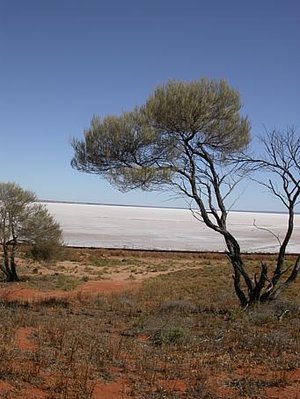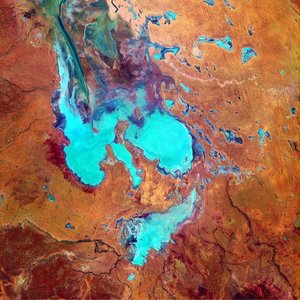Endorheic
|
|
In geography, an endorheic basin is a watershed from which there is no outflow of water (either on the surface as rivers, or underground by flow or diffusion through rock or permeable material). The term has Greek roots, endo, "inside" and rhein, "to flow". Any rain (or other precipitation) that falls inside an endorheic basin remains there permanently, leaving the system only by evaporation. Endorheic basins are also called "internal drainage systems".
Although, in theory, endorheic basins can occur in any climate, in practice they are most commonly found in hot desert locations. In places with a higher rainfall, the riparian erosion of the water's flow will generally carve drainage channels (particularly in times of flood), breaking through to the larger enclosing hydrological system, and breaking the watershed barrier between the endorheic system and the surrounding terrain. The Black Sea is such a lake, having once been an independent hydrological system in its own right before the Mediterranean Sea broke through the terrain separating the two.
In hot deserts, the net inflow is low and loss to solar evaporation high, drastically slowing the formation of complete drainage systems. The closed nature of this water flow often leads to the concentration of salts and other minerals in the lake; minerals leached from the surrounding rocks are deposited in the endorheic basin, and left behind when the water that bore them there evaporates. Thus endorheic basins often contain extensive salt pans (alkali flats) or playas. These areas, which tend to be large, hard surfaced, and fairly flat, are sometimes used for aviation (as large cheap runways) or for breaking land speed records.
Both permanent and seasonal endorheic lakes can form in endorheic basins, and some endorheic basins are essentially in stasis, the climate having changed to reduce precipitation to such an extent that a lake no longer forms. Even with endorheic lakes that exist permanently, most change size and shape dramatically over time, often becoming dramatically smaller (or breaking into several smaller parts) during the dry season. As humans have expanded into previously unliveable desert areas, the river systems that feed many endorheic lakes have been altered by the construction of dams and aqueducts. As a result many endorheic lakes in developed or developing countries have contracted dramatically. This often results in dramatic increases in salinity, higher concentrations of pollutants, and the consequent disruption of the lake's ecosystem.
Notable endorheic basins and lakes
- Much of western and Central Asia is a single, giant inland basin. It contains a number of lakes, including:
- The Caspian Sea, the largest on Earth (actually a small ocean).
- The Aral Sea. Here the diversion of the sea's tributary rivers has led to a dramatic shrinkage of the lake, and the resulting ecological disaster has brought the plight faced by internal drainage basins to public attention.
- Eastern Kazakhstan's Lake Balkhash
- Kyrgyzstan's Issyk_Kul
- The Dead Sea in the Middle East, the saltiest major body of water in the world (so salty that a person can float unaided in it).
- The Lake Eyre Basin is the largest endorheic system in the world. It includes much of the landmass of arid inland Australia drains into the highly variable Lake Eyre.
- One of the few endorheic lakes in cold desert locations, Antarctica's Lake Vida remains liquid because its salinity is seven times that of seawater.
- The US's Great Basin, which covers much of Nevada and Utah, and includes:
- The Black Rock Desert in Nevada, location of the Thrust2 and ThrustSSC landspeed record runs, and the annual home to the Burning Man festival.
- Groom Dry Lake in Nevada, location of the secret Area 51 base.
- Utah's Great Salt Lake
- Pyramid Lake
- California's Salton Sea, a lake accidentally created in 1905 when irrigation canals ruptured, filling a desert endorheic basin and recreating an ancient saline sea.
Ancient endorheic basins
Some of the Earth's ancient endorheic systems include:
- the Black Sea, until its merger with the Mediterranean
- Lake Lahontan in the western US
- Ebro and Duero basins, draining most of northern Spain during the Neogene and perhaps Pliocene.
- Lake Bonneville (Utah)
External link
- Primer on endorheic lakes (http://www.unep.or.jp/ietc/Publications/Short_Series/LakeReservoirs-2/10.asp)de:Salzsee


